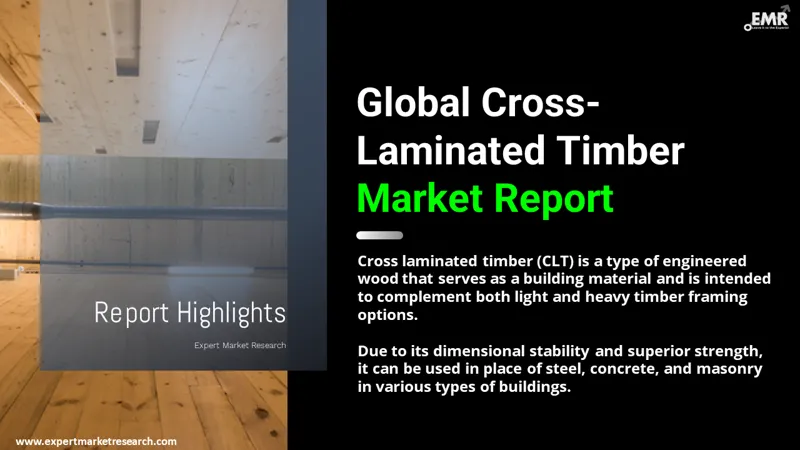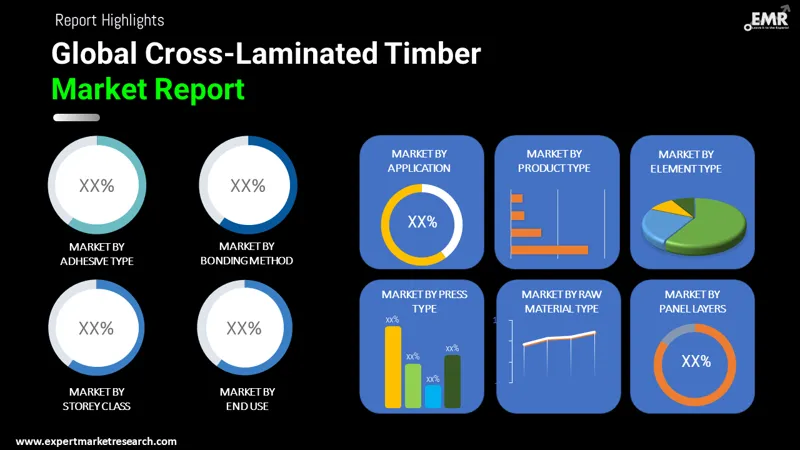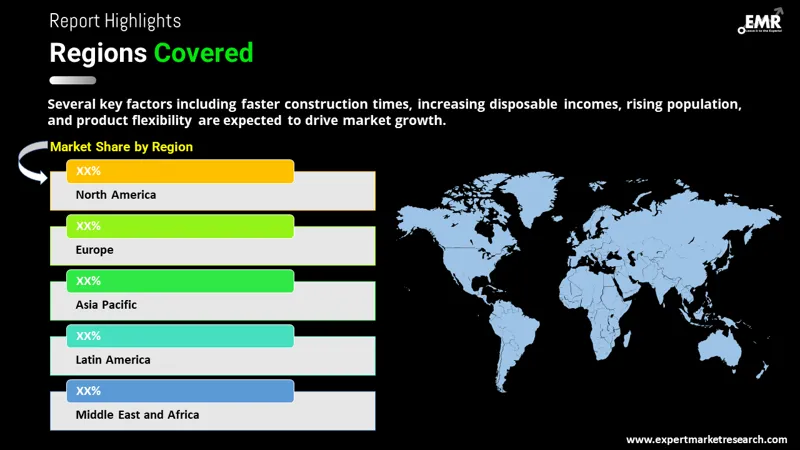
Consumer Insights
Uncover trends and behaviors shaping consumer choices today
Procurement Insights
Optimize your sourcing strategy with key market data
Industry Stats
Stay ahead with the latest trends and market analysis.
Base Year
Historical Year
Forecast Year




The global cross-laminated timber market attained a value of USD 1,574.10 million in 2023. The market is expected to further grow at a CAGR of 11.4% in the forecast period of 2024-2032 to reach USD 4,142.33 million by 2032.
| Global Cross-Laminated Timber Market Report Summary | Description | Value |
| Base Year | USD Million | 2023 |
| Historical Period | USD Million | 2018-2023 |
| Forecast Period | USD Million | 2024-2032 |
| Market Size 2023 | USD Million | 1,574.10 |
| Market Size 2032 | USD Million | 4,142.33 |
| CAGR 2018-2023 | Percentage | XX% |
| CAGR 2024-2032 | Percentage | 11.4% |
| CAGR 2024-2032 - Market by Region | Asia Pacific | 13.1% |
| CAGR 2024-2032 - Market by Country | India | 15.0% |
| CAGR 2024-2032 - Market by Country | China | 12.5% |
| CAGR 2024-2032 - Market by Product Type | Custom CLT | 12.5% |
| CAGR 2024-2032 - Market by Adhesive Type | PUR (Polyurethane) | 12.8% |
| Market Share by Country 2023 | France | 3.1% |

Read more about this report - REQUEST FREE SAMPLE COPY IN PDF
The cross-laminated timber market is currently being driven by the increasing construction activities and the rising demand coming from the education sector and residential and non-residential applications. These are putting pressure on the supplies of traditional materials and prompting developers to look for speedier alternatives like cross-laminated timber and hence bolstering the cross-laminated timber demand.
Another significant driver of the market is the increasing demand for biophilic design in architecture. Cross-laminated timber exploits the trend of incorporating natural elements into urban environments with its aesthetic appeal, which is natural. Added health benefits, such as improvement in air quality and enhancement of well-being, are also aligned with the trend. This design approach tends to support both sustainability and occupant satisfaction, hence propelling the growth of the cross-laminated timber market.
Sustainable building practices, technological advancements, and high-density developments are some of the factors opening up new cross-laminated timber market opportunities.
June 2024
Mayr-Melnhof Holz decides on the investment in a fully automated state-of-the-art high-frequency press for standard glulam components at its Olsberg location in Germany. With its new pressing system, Olsberg is taking a qualitative leap into the automated processing of production orders and is timely state-of-the-art in providing the straight components required for the glulam standard business.
September 2023
The New York City Economic Development Corporation (NYCEDC) announced the creation of the New York City Mass Timber Studio: "a technical assistance program to support active mass timber development projects in the early phases of project planning and design."
November 2022
Stora Enso and Voodin Blade Technology GmbH have partnered to develop wooden wind turbine blades as part of their sustainability drive. The companies make commitments to develop sustainable alternatives for wind turbine blades and establish a competitively reliable supply chain.
October 2022
Stora Enso has opened a new production unit for cross-laminated timber in Ždírec, the Czech Republic. Following an investment of EUR 79 million, this new CLT unit will be one of the most modern in the world and will support the Stora Enso strategy to grow within wooden building solutions.
Sustainable Building Practices
There is a need for eco-friendly construction, and thus the demand of the cross-laminated timber market is induced. With reduced carbon footprint and renewable material use, among others, cross-laminated timbers support global sustainability goals and pressures from regulators.
Technological Advancements
Improvements to the production process and construction techniques for cross-laminated timber continue to increase material performance and design flexibility, from a variety of manufacturing process improvements through new applications in taller structures, further broadening the use of CLT in a wide array of building types.
Urbanization and High-Density Development
Increasing urbanisation is creating demand for cross-laminated timber in mid-rise and high-rise buildings and hence boosting the cross-laminated timber market revenue. The light weight of the material and efficient construction methods make cross-laminated timber ideal to meet the increasing demand for high-density, sustainable housing and commercial space needs of growing cities.
Growing Market Adoption
There is increasing adoption of cross-laminated timber across regions, with positive policies and a rise in awareness of the material's advantages being promoted. Factors pushing the growth of cross-laminated timber industry include the increase in production capacities, growth in the number of projects using cross-laminated timber, and further integration in the use of residential, commercial, and public buildings.
Cross-laminated timber (CLT) is engineered wood used as building material and designed to complement the light- and heavy-timber framing options. Owing to its dimensional stability and high strength, it can be used as an alternative to steel, concrete, and masonry in many building types. It is more economical, environmentally friendly as it emits less greenhouse gas, it is easy and fast to install as it is prefabricated and provides flexibility in design as it is lightweight and strong.
A key trend of the cross-laminated timber market is the increasing integration of advanced digital technologies into design and construction. Building information modelling (BIM) and other digital technologies help realise CLT projects with better precision, efficiency, and personalization. This enables increasingly complex and innovative applications in modern architecture.

Read more about this report - REQUEST FREE SAMPLE COPY IN PDF
“Global Cross-Laminated Timber Market Report and Forecast 2024-2032” offers a detailed analysis of the market based on the following segments:
On the basis of application, the market is divided into:
Based on product type, the industry is segmented into:
On the basis of element type, the industry is divided into:
Based on raw material type, the industry is segregated into:
On the basis of bonding methods, the industry is divided into:
Based on panel layers, the market is segmented into:
On the basis of adhesive type, the industry is categorised into:
Based on press type, the industry is divided into:
Based on storey class, the industry is categorised into:
Based on end-uses, the industry is segmented into:
Commercial Application To Gain Significance Due To Demand In Sustainable And Cost-Effective Building Solutions
The commercial segment is expected to have a quite dominant share in the cross-laminated timber market. It is also driven by increasing demands from commercial sectors of office buildings, retail spaces, and hospitality structures for more sustainable, attractive, and economical construction methods. In commercial applications, the adoption of CLT has been especially very appealing since it allows for faster construction time and lesser environmental impacts, thus making performance versus sustainability, not an either-or proposition. Ultimately, this leads to an increase in the cross-laminated timber industry revenue globally.
Mid-Rise Buildings (5-10 Storeys) To Use CLT On A Wide Scale For Structural Efficiency
As per cross-laminated timber industry analysis, the mid-rise buildings (5-10 storeys) segment is likely to drive tremendous growth. Such a segment reaps all the benefits from the combination of CLT's structural strength with lighter weight, hence being quite perfect for buildings that are taller than low-rise and less demanding than high-rises. Applications in the mid-rise balance cost with performance and sustainability, highlighting the benefits of using CLT in residential and commercial applications. It is this growing focus on urban density and sustainable development that further drives interest in mid-rise CLT construction.

Read more about this report - REQUEST FREE SAMPLE COPY IN PDF
Europe Is Likely To Acquire Dominant Market Share Owing To Sustainable Construction Practices
The cross-laminated timber industry in Europe is expected to hold the leading share in the cross-laminated timber market. The primary reason behind this supremacy is the robust regulatory support that sustainable construction practices have been enjoying in Europe, coupled with major investments in green building technologies and an existing well-established network of producers of cross-laminated timber.
Austria, Germany, and Sweden dominate in terms of innovation and production of cross-laminated timber, including enabling policies and rising adoption of eco-friendly construction methods. Furthermore, the well-established market infrastructure in this mature market and growing concern of European nations toward reducing carbon footprints also support the region's lead in the global cross-laminated timber market.
| CAGR 2024-2032 - Market by | Country |
| India | 15.0% |
| China | 12.5% |
| UK | 10.4% |
| USA | 10.1% |
| Germany | 9.3% |
| Canada | XX% |
| France | XX% |
| Italy | XX% |
| Japan | 7.8% |
| Australia | XX% |
| Saudi Arabia | XX% |
| Brazil | XX% |
| Mexico | XX% |
The key players in the cross-laminated timber market are mainly involved in developing technologies, increasing production capacities, entering into strategic partnerships, and improving sustainability performance to meet growing demand and increasingly strict environmental legislation.
The Stora Enso Group, founded in 1998 and headquartered in Helsinki, Finland, supplies a diversified portfolio of sustainable building materials, including Cross-Laminated Timber and Glulam. Their products highlight eco-friendliness with superior engineering in support of the modern needs of construction.
Binderholz GmbH, Fügen, Austria-based, was established in 1956 to specialize in Cross-Laminated Timber, Glulam, and other solid wood products. Quality and structural performance are guaranteed with the company's products, thereby promoting sustainable and innovative building solutions.
Mayr Melnhof Holz Group has been in business since 1986, with its headquarters in Leoben, Austria. It offers a comprehensive range of engineered wood products, from CLT and Glulam. Their concentration will be on linking leading technology with sustainability, adding construction effectiveness, and ecological obligation for a better future.
Schilliger Holz AG is a company founded in 1960 and located in Lenzburg, Switzerland and produces a wide array of timber products, from CLT to other wooden solutions involving engineered wood. Besides this, the firm comes up with high-grade, benign products harmonised with contemporary architecture and building demands.
Other key players in the cross-laminated timber market are KLH Massivholz GmbH, HASSLACHER Holding GmbH, Sterling Company, Structurlam Mass Timber Corporation, Nordic Structures, and Eugen Decker Holzindustrie KG, among others.
| REPORT FEATURES | DETAILS |
| Base Year | 2023 |
| Historical Period | 2018-2023 |
| Forecast Period | 2024-2032 |
| Scope of the Report |
Historical and Forecast Trends, Industry Drivers and Constraints, Historical and Forecast Market Analysis by Segment:
|
| Breakup by Application |
|
| Breakup by Product Type |
|
| Breakup by Element Type |
|
| Breakup by Raw Material Type |
|
| Breakup by Bonding Method |
|
| Breakup by Panel Layers |
|
| Breakup by Adhesive Type |
|
| Breakup by Press Type |
|
| Breakup by Storey Class |
|
| Breakup by End Use |
|
| Breakup by Region |
|
| Market Dynamics |
|
| Competitive Landscape |
|
| Companies Covered |
|
| Report Price and Purchase Option | Explore our purchase options that are best suited to your resources and industry needs. |
| Delivery Format | Delivered as an attached PDF and Excel through email, with an option of receiving an editable PPT, according to the purchase option. |
Cross-Laminated Timber Market Size
Cross Laminated Timber Market Growth
Cross Laminated Timber Market Trends
Cross Laminated Timber Market Share
Cross-Laminated Timber Market Analysis
*While we strive to always give you current and accurate information, the numbers depicted on the website are indicative and may differ from the actual numbers in the main report. At Expert Market Research, we aim to bring you the latest insights and trends in the market. Using our analyses and forecasts, stakeholders can understand the market dynamics, navigate challenges, and capitalize on opportunities to make data-driven strategic decisions.*
Get in touch with us for a customized solution tailored to your unique requirements and save upto 35%!
In 2023, the global cross-laminated timber market attained a value of nearly USD 1,574.10 million.
The cross-laminated timber market is projected to grow at a CAGR of 11.4% between 2023 and 2032.
By 2032, the market is projected to reach USD 4,142.33 million.
The major market drivers include rising population, increasing construction activities, and the flexibility offered by cross-laminated timber.
The rising awareness about the advantages of cross-laminated timber over other traditional construction materials and the growing focus on reducing construction time are the key trends fuelling the market growth.
The major regions in the cross-laminated timber market are North America, Europe, Japan, and Oceania, among the rest of the world.
The major applications of cross-laminated timber are residential, public, and commercial.
The leading product types in the market are custom CLT and blank CLT.
The significant element types in the market are wall panels, flooring panels, and roofing panels.
The major raw material types of the product include spruce, pine, and fir, among others.
The significant bonding methods of the product are adhesively bonded and mechanically fastened.
The major panel layers of the product are 3-Ply, 5-Ply, and 7-Ply, among others.
The several adhesive types considered in the market report are PUR (Polyurethane), PRF (Phenol Resorcinol Formaldehyde), and MUF (Melamine-Urea-Formaldehyde).
The significant press types of the product include hydraulic press, vacuum press, and pneumatic press, among others.
The significant storey classes of the product are low-rise buildings (1-4 storeys), mid-rise buildings (5-10 storeys), and high-rise buildings (more than 10 storeys).
The major end uses of the product include structural applications and non-structural applications.
The major players in the market are Stora Enso Group, Binderholz GmbH, Mayr Melnhof Holz Group, Schilliger Holz AG, KLH Massivholz GmbH, HASSLACHER Holding GmbH, Sterling Company, Structurlam Mass Timber Corporation, Nordic Structures, and Eugen Decker Holzindustrie KG, among others.
Purchase Full Report





Datasheet
Single User License
One User
Five User License
Five Users
Corporate License
Unlimited Users
How To Order
Our step-by-step guide will help you select, purchase, and access your reports swiftly, ensuring you get the information that drives your decisions, right when you need it.

Select License Type
Choose the right license for your needs and access rights.

Click on ‘Buy Now’
Add the report to your cart with one click and proceed to register.

Select Mode of Payment
Choose a payment option for a secure checkout. You will be redirected accordingly.
Gain insights to stay ahead and seize opportunities.

Get insights & trends for a competitive edge.

Track prices with detailed trend reports.

Analyse trade data for supply chain insights.

Leverage cost reports for smart savings

Enhance supply chain with partnerships.

Connect For More Information
Our expert team of analysts will offer full support and resolve any queries regarding the report, before and after the purchase.
Our expert team of analysts will offer full support and resolve any queries regarding the report, before and after the purchase.
We employ meticulous research methods, blending advanced analytics and expert insights to deliver accurate, actionable industry intelligence, staying ahead of competitors.
Our skilled analysts offer unparalleled competitive advantage with detailed insights on current and emerging markets, ensuring your strategic edge.
We offer an in-depth yet simplified presentation of industry insights and analysis to meet your specific requirements effectively.
Australia
63 Fiona Drive, Tamworth, NSW
+61 448 06 17 27
India
C130 Sector 2 Noida, Uttar Pradesh 201301
+91-858-608-1494
Philippines
40th Floor, PBCom Tower, 6795 Ayala Avenue Cor V.A Rufino St. Makati City,1226.
+63 287899028, +63 967 048 3306
United Kingdom
6 Gardner Place, Becketts Close, Feltham TW14 0BX, Greater London
+44-753-713-2163
United States (Head Office)
30 North Gould Street, Sheridan, WY 82801
+1-415-325-5166
Vietnam
193/26/4 St.no.6, Ward Binh Hung Hoa, Binh Tan District, Ho Chi Minh City
+84865399124